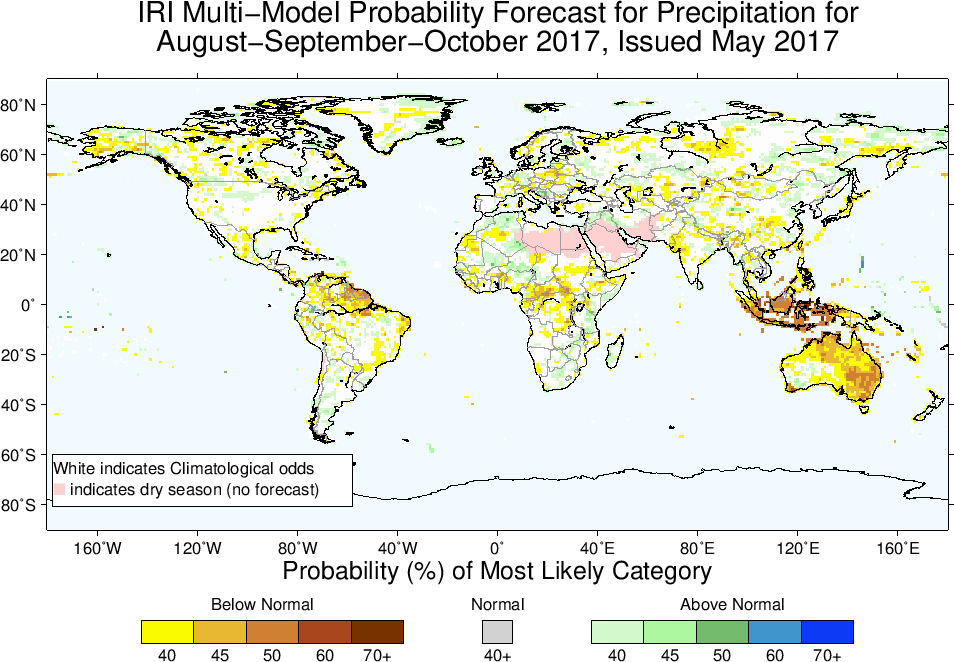May Climate Briefing: El Niño Odds Down Slightly
Read our ENSO Essentials & Impacts pages for more about El Niño.
Tony Barnston provides an overview of the briefing
Since last month’s briefing, weekly sea-surface temperature anomalies have increased slightly to +0.4ºC to +0.5ºC in the area of the central equatorial Pacific Ocean that define El Niño and La Niña events, called the Nino3.4 region (see first image below). These sea-surface temperatures (SSTs) point to a borderline neutral-weak El Niño ENSO state, although these weak anomalies are not enough to constitute an El Niño event, especially given the short period of time. Another key ingredient for an El Niño event is the weakening and even reversal of tradewinds in the central equatorial Pacific, and we’ve not yet seen consistent evidence of this atmospheric El Niño component.
Also in the last month, the convection (i.e. clouds and thunderstorms) that was lingering over Indonesia in a La Niña-like pattern has now faded (see second image).
The National Oceanic and Atmospheric Administration’s Climate Prediction Center’s ENSO alert system status is currently listed as Not Active.


ENSO Forecasts
To predict ENSO conditions, computers model the SSTs in the Nino3.4 region over the next several months. The graph in the first image of the gallery below shows the outputs of these models, some of which use equations based on our physical understanding of the system (called dynamical models), and some of which use statistics, based on the long record of historical observations.
Despite the warming sea surface temperature since last month, the future temperatures predicted by the mean of the models have decreased since last month’s forecast. This decrease stems in particular from results of the dynamical models; the dynamical model mean for the rest of the year is around +0.75ºC — down around 0.25ºC from last month’s mean, but still in the weak El Niño range. The mean of the statistical models is similar to that of last month; the statistical models call for SSTs to remain right around the El Niño threshold of +0.5ºC through the year.
This month’s forecast extends past what’s known as the spring predictability barrier — a function of ocean dynamics that makes it hard to predict ENSO conditions past June of each year. While uncertainty is still high, the spread of the model predictions has tightened some since last month. All but one model falls within a 1.5ºC range, compared to a nearly 2.5ºC spread of model predictions last month.

Based on these model outputs, odds for La Niña are at 10% or less for the rest of the year (see second graph in gallery above). El Niño is the most likely ENSO outcome for the rest of the year, but the odds are slightly down compared to last month, topping out at around 60%. Note that the probabilities in this figure don’t give an indication of the potential strength of an El Niño event, only the odds that Nino3.4 SSTs will be at least 0.5ºC above average.
ENSO in context: Resource page on climate variability
The official probabilistic forecast issued by CPC and IRI in early May indicates comparatively somewhat less likelihood for an El Niño event, with similar odds for both neutral and El Niño conditions for the rest of the year. This early-May forecast uses human judgement in addition to model output, while the mid-May forecast relies solely on model output. More on the difference between these forecasts in this recent IRI Medium post.
Effects of La Niña on global seasonal forecasts
Each month, IRI issues seasonal climate forecasts for the entire globe. These forecasts take into account the latest model outputs and indicate which areas are more likely to see above- or below-normal temperatures and rainfall.

For the upcoming seasons, the forecasts show some signal from ENSO, such as increased chances for drier-than-normal conditions in northeastern South America, central Africa, Indonesia and Australia (see August-October season above). All forecast maps are available on our seasonal forecast page.
Learn more about El Niño and La Niña on our ENSO resources page, and sign up here to get notified when the next forecast is issued. In the meantime, check out #IRIforecast.
Note: Beginning last month, the IRI probabilistic seasonal climate forecast product is based on a re-calibration of model output from the NOAA’s North American Multi-Model Ensemble Project (NMME). The output from each NMME model is re-calibrated prior to multi-model ensembling to form reliable probability forecasts. The forecasts are now presented on a 1-degree latitude-longitude grid. More on this change on the seasonal forecast page.
Coming soon: look for a Q&A with our climate scientists about the new forecast.


You must be logged in to post a comment.